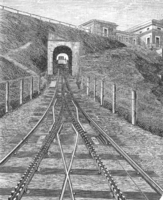Abbot's switch

The abtsche Soft (also Abt'sche Soft or abtsche turnout is) one of the Swiss railway engineer Carl Roman Abt as "passive crossover" invented track design for funiculars , which allows an automatic pass-by of vehicles at a passing place single-track trails.
history

|

|
|
|
First execution of the Abt switch on the Giessbach Railway, which deviated from the current execution, the railway was converted to the current system in 1890.
|
||
The first Abt switch was installed on the Giessbachbahn , which opened in 1879 , which also became the first single-track funicular railway. In August 2015, the American Society of Mechanical Engineers recognized the railway as a historical monument of mechanical engineering for the first use of the Abt switch . Corresponding memorial plaques are located in the valley and mountain stations.
The design of the Abt switch used on the Giessbachbahn did not yet correspond to the one currently used, which means that the chassis of the cars had to be designed differently - one car used external wheel flanges , the other internal. In the track system, only the left rail could be made continuous, while the right rail was interrupted so that the wagon with the external wheel flanges could drive on the siding. Because of the gaps in the right-hand rail and the additionally required wheel guides, the track system became more complicated and maintenance-intensive than the type used today.
The current version of the Abt switch was first used in 1886 on the Lugano – SBB funicular railway . In the winter of 1890/1891 the Giessbachbahn was rebuilt to the design that is common today.
Working principle
This switch construction without switch tongue and other moving parts is used at the passing points of single-track funicular railways necessary in the middle of the route , in order to manage the passage of oncoming vehicles or train cabins automatically ("automatically"). It can also lie in a curve and does not necessarily have to be built in a straight direction. The Abt switch also enables problem-free guidance of the drive cable, which is correctly guided into the respective siding with inclined rollers between the rails.
Each wheel set of a wagon is equipped with two different wheels: on one side of the wagon with a double flanged wheel or double flange wheel - a wheel that has flanges on both sides , and on the other side with a wide roller wheel without flanges. Of the two cars, which are operated in opposite directions on the single-track line, one has the double flange wheels on the right and the other on the left. The wagons are only guided by the double flange wheels on the entire route.
At the passing point , both rails lead to the outside and the double flange wheels belonging to these rails always lead the respective car to the same side. Regardless of the direction of travel, one car always drives on the right and the other always on the left. For this purpose, the pull ropes are also deflected to the corresponding side by means of inclined support rollers. The wide roller wheels on the other side serve to pass over the gaps for the cable feed-through and for the passage of the inner flanges of the double flange wheels without large bumps. By flangeless loose Walzräder none are core components necessary.
Resilience
Because the switch has no moving parts, it is largely maintenance-free and completely fail-safe, which is an important safety factor for railways of this type with their sometimes very steep stretches.
operation area
Abt turnouts are used on funiculars on the mountain as well as on the plain. It is also possible to operate aerial tramways with self-propelled vehicles such as cog railways. They cannot be used if standard vehicles with normal wheel sets are to be transported on the funicular. One example is the Trieste – Opicina railway line .
Abtsche Weiche funicular railway Lugano – Bahnhof SBB (Switzerland)
Abt switch of the Petřín funicular railway (Czech Republic)
Abtsche switch of the Skansens Bergbana (Sweden)
Abt switch of the Schloßbergbahn (Graz) (Austria)
Wheel set from Heidelberg , on the left the double flange wheel, on the right the roller wheel
Others
Because the cars at the terminal stops reverse their direction of travel without turning the vehicle, traffic at the Abt switch alternates between left and right-hand traffic for technical reasons . Each car always drives through on "its" side of the passing point, regardless of whether it is going up or down.
literature
- R. Abt: Cable car Lugano: System Abt . In: Schweizerische Bauzeitung . tape 9 , no. 6 , 1887, p. 38 , doi : 10.5169 / SEALS-14347 (contemporary description of the Abt switch in today's design).
Web links
- Abt switch at the Petřín funicular in Prague
- Abt switch at the Petřín funicular in Prague in detail
- Abt switch at the Petřín funicular in Prague from another direction
- Abtsche turnout at the summer mountain railway in Bad Wildbad (Black Forest)
Individual evidence
- ^ Giessbachbahn funicular named mechanical engineering. ASME, August 27, 2015, accessed December 22, 2019 .
- ↑ Grand Hotel Giessbach (ed.): Giessbach funicular . S. 6 ( giessbach.ch [PDF]).
- ^ R. Abt: The cable car at Giessbach . In: The Railway . 1879, p. 103-104 , doi : 10.5169 / SEALS-7731 .
- ^ R. Abt: The cable car at Giessbach . 1879, doi : 10.5169 / SEALS-7733 (supplement with panel III Oberbau Seilbahn am Giessbach ).
- ↑ Literature . Presentation of Adolf Wild: The funicular on Giessbach. In: Railway amateur . No. 9 , 2017, p. 427 .
- ↑ 3855.01 Giessbach See boat station - Giessbach Grandhotel. In: standseilbahnen.ch.






